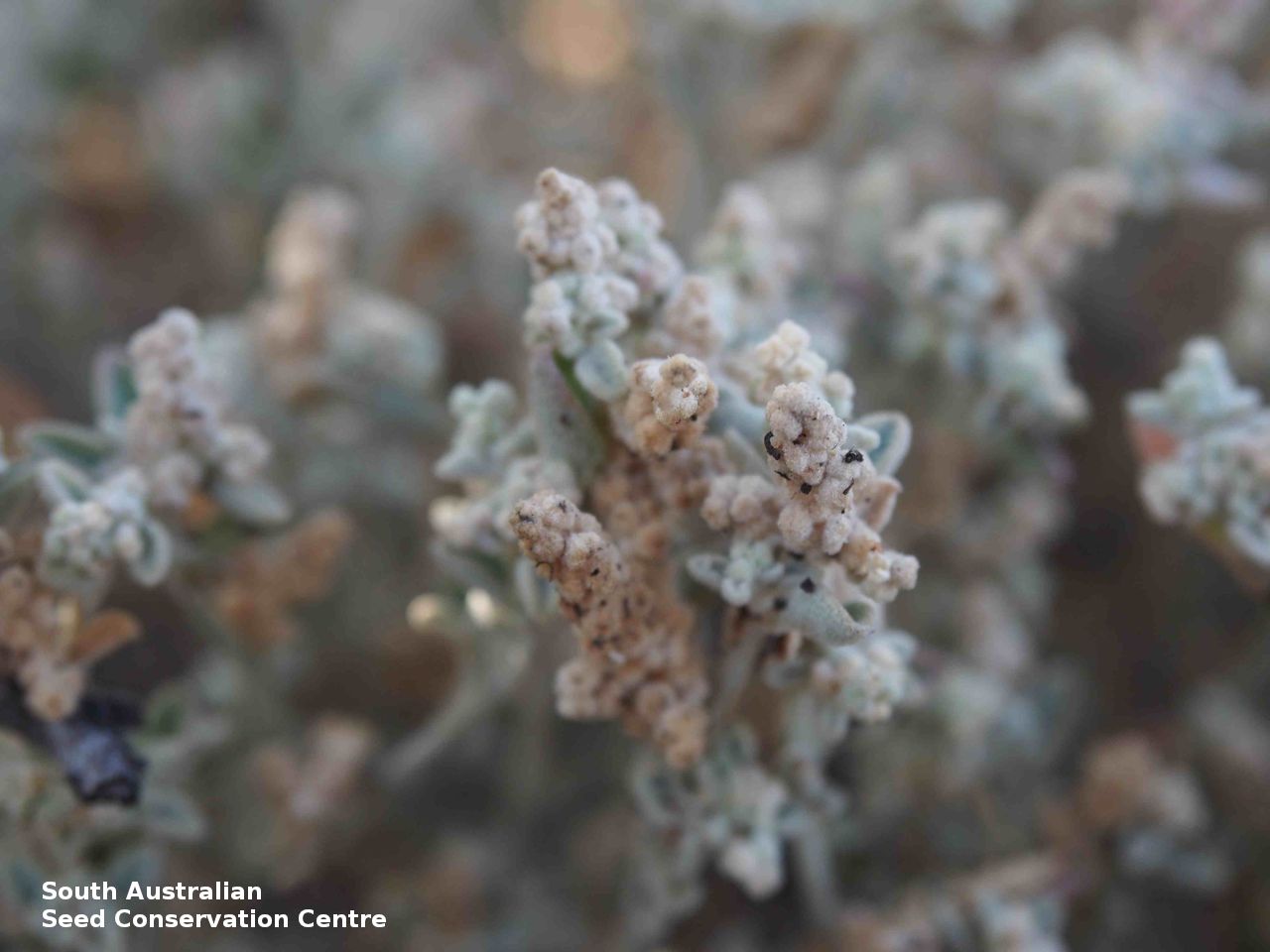Desert Goosefoot,
Frosted Goosefoot
Display all 13 images













Regional Species Conservation Assessments per IBRA subregion.


Least concern
Near threatened
Rare
Vulnerable
Endangered
Critically endangered
Extinct
Data deficient
Adelaide
Arkaroola
Ceduna
Coober Pedy
Hawker
Innamincka
Marla
Marree
Mount Gambier
Oodnadatta
Renmark
Wudinna
Keith
Yunta
Display IBRA region text
| Fleurieu (KAN02) | Kanmantoo | Near Threatened [edge of range] |
| Mount Lofty Ranges (FLB01) | Flinders Lofty Block | Rare (IUCN: RA d(i,ii)) [edge of range] |
| Broughton (FLB02) | | Least Concern |
| Olary Spur (FLB03) | | Least Concern |
| Southern Flinders (FLB04) | | Least Concern |
| Northern Flinders (FLB05) | | Least Concern |
| Central Flinders (FLB06) | | Least Concern |
| St Vincent (EYB02) | Eyre Yorke Block | Least Concern |
| Eyre Hills (EYB03) | | Least Concern |
| Eyre Mallee (EYB05) | | Least Concern |
| South Olary Plain (MDD01) | Murray Darling Depression | Least Concern |
| Murray Mallee (MDD02) | | Least Concern |
| Murray Lakes and Coorong (MDD03) | | Rare (IUCN: RA d(i,ii)) [edge of range] |
| Lowan Mallee (MDD04) | | Least Concern [limited to northern section] |
| Braemer (MDD07) | | Least Concern |
| Murray Scroll Belt (RIV06) | Riverina | Least Concern |
| Myall Plains (GAW01) | Gawler | Least Concern |
| Gawler Volcanics (GAW02) | | Least Concern |
| Gawler Lakes (GAW03) | | Near Threatened |
| Arcoona Plateau (GAW04) | | Rare (IUCN: RA d(ii)) |
| Kingoonya (GAW05) | | Least Concern |
| Roxby (GAW07) | | Least Concern |
| Commonwealth Hill (GAW08) | | Least Concern |
| Maralinga (GVD03) | Great Victoria Desert | Least Concern |
| Kintore (GVD04) | | Least Concern |
| Tallaringa (GVD05) | | Least Concern |
| Yellabinna (GVD06) | | Least Concern |
| Carlisle (NUL01) | Nullarbor | Rare (IUCN: RA d(ii)) |
| Nullarbor Plain (NUL02) | | Rare (IUCN: RA d(ii)) |
| Yalata (NUL03) | | Rare (IUCN: RA d(ii)) |
| Curnamona (BHC06) | Broken Hill Complex | Least Concern |
| Breakaways (STP01) | Stony Plains | Near Threatened |
| Murnpeowie (STP03) | | Near Threatened |
| Macumba (STP05) | | Rare (IUCN: RA d(i,ii)) |
| Mann-Musgrave Block (CER01) | Central Ranges | Least Concern |
| Watarru (CER02) | | Least Concern |
| Everard Block (CER03) | | Least Concern |
| Fleurieu (KAN02) | Kanmantoo | Near Threatened [edge of range] |
| 6 of 6 subregions | Flinders Lofty Block | Least Concern , Rare |
| 3 of 5 subregions | Eyre Yorke Block | Least Concern |
| 5 of 6 subregions | Murray Darling Depression | Least Concern , Rare |
| Murray Scroll Belt (RIV06) | Riverina | Least Concern |
| 7 of 8 subregions | Gawler | Least Concern , Near Threatened , Rare |
| 4 of 4 subregions | Great Victoria Desert | Least Concern |
| 3 of 3 subregions | Nullarbor | Rare |
| Curnamona (BHC06) | Broken Hill Complex | Least Concern |
| 3 of 7 subregions | Stony Plains | Near Threatened , Rare |
| 3 of 3 subregions | Central Ranges | Least Concern |
Botanical art
Kath Alcock paintings: 2
Prior names
Chenopodium microphyllum var. desertorum
Common names
Desert Goosefoot
Frosted Goosefoot
Etymology
Chenopodium from the Greek 'chen' meaning goose and 'pod' meaning foot, referring to the shape of the leaves in some species. Desertorum from the Greek 'desertorum' meaning to grow in deserts.
Distribution and status
Found across drier South Australia except on the Yorke Peninsula, Kangaroo Island, southern Mount Lofty Ranges and the South-east growing in mallee and dry woodland. Also found in Western Australia, Northern Territory, New South Wales and Victoria.. Native. Common in South Australia. Uncommon in the other States.
Herbarium regions: North Western, Lake Eyre, Nullarbor, Gairdner-Torrens, Flinders Ranges, Eastern, Eyre Peninsula, Northern Lofty, Murray, Yorke Peninsula
NRM regions: Alinytjara Wilurara, Eyre Peninsula, Northern and Yorke, South Australian Arid Lands, South Australian Murray-Darling Basin
AVH map: SA distribution map (external link)
Plant description
Annual or perennial herb, prostrate to erect much branched herb to 20 cm high. Leaves densely covered when young with colourless glistening transparent disc hairs, opposite or alternate, triangular, hastate or elliptic to 8 mm long. Inflorescence congested or lax, narrow-pyramidal or slender, exceeding the terminal leaves; flowers to 2 mm diameter, perianth with a felty indumentum of glistening vesicular hairs. Flowering in summer. Fruits are fruit enveloped by perianth; pericarp membranous to succulent. Seeds are black globular reniform seed to 1.5 mm diameter, almost smooth to slightly rugulose or striate. Seed embryo type is peripheral.
Seed collection and propagation
Collect seeds between January and December. Collect fruit-heads that are maturing, turning pale brown firm black seeds inside. Place the fruits-heads in a tray and leave to dry for one to two weeks. Then gently rub the fruits with your fingers or a rubber bung to dislodge the seeds. Use a sieve to seperate the unwanted material. Store the seeds with a desiccant such as dried silica beads or dry rice, in an air tight container in a cool and dry place. This species has physiological dormancy that needs to be overcome for the seed to germinate (e.g. nicking or softening the seed coat). Germination 89%, seed scarified (covering structure removed and seed coat chipped), on 1% w/v agar supplemented with 101mg/L potassium nitrate, 12/12 dark/light, 16°C. See http://data.kew.org/sid
Germination table:
Display












